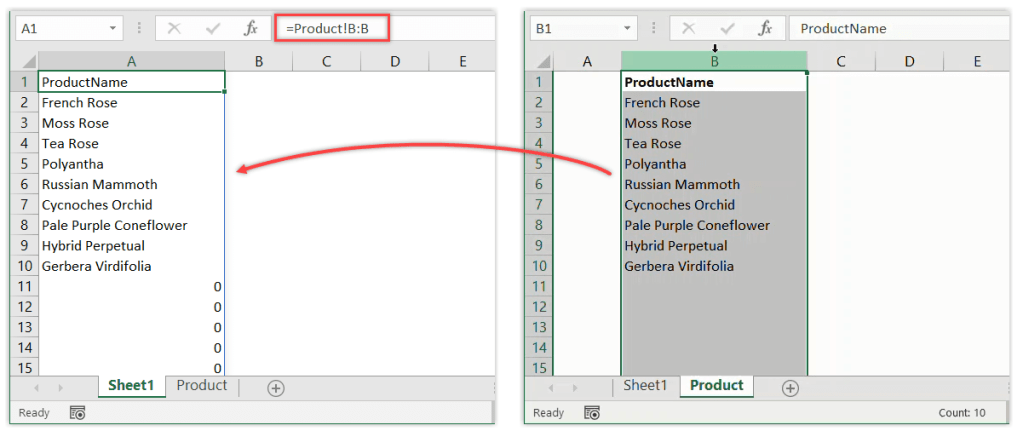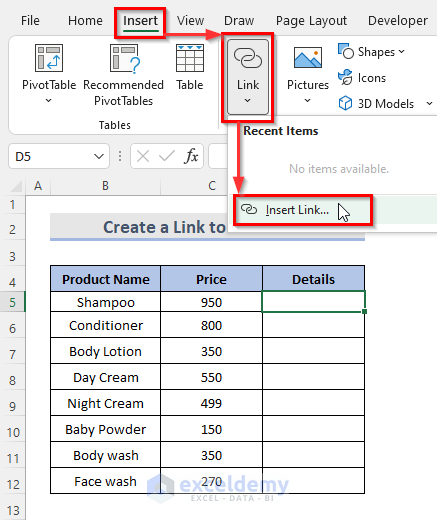5 Ways to Link Data in Excel Sheets

Linking data between Excel sheets can greatly enhance efficiency, accuracy, and data integrity in your spreadsheets. Whether you're managing financial data, employee records, or project schedules, knowing how to effectively connect data across various sheets is a crucial skill. Here are five methods to link data, each serving different purposes and offering unique benefits.
Method 1: Using Cell References

Why Use Cell References? This method is perhaps the simplest way to pull data from one sheet to another. It’s perfect for static data where the source doesn’t change frequently.
- Click on the cell where you want the linked data to appear.
- Type '=' followed by switching to the source sheet, selecting the desired cell, and pressing Enter. For example, '=Sheet2!A1' to link cell A1 from Sheet2 to your current location.
- Excel will now display the value from the referenced cell, updating automatically if the source cell changes.
📝 Note: If you rename or move sheets, make sure to update the references to avoid errors.
Method 2: Named Ranges for Dynamic Links

Named ranges are useful for linking to data that might expand or shrink over time or for references that are reused across multiple sheets or workbooks.
- Define a named range on the source sheet by selecting the cells, right-clicking, choosing 'Name a Range', and giving it a name.
- On the destination sheet, use the name to refer to the range. For instance, if you named the range 'SalesData', you could link to it by typing '=SalesData'.
Benefits:
- Easy to remember and use in formulas.
- Less prone to errors as the range automatically adjusts when data expands or contracts.
Method 3: Lookup Functions (VLOOKUP, HLOOKUP, INDEX/MATCH, XLOOKUP)

Lookup functions are essential when you need to link data based on specific criteria.
- VLOOKUP: For vertical lookups, use '=VLOOKUP(lookup_value, table_array, col_index_num, [range_lookup])'.
- HLOOKUP: For horizontal lookups.
- INDEX/MATCH: More flexible than VLOOKUP as it allows for lookup to the left.
- XLOOKUP: Introduced in newer versions, this function combines the capabilities of VLOOKUP and HLOOKUP with greater ease of use.
Usage Example:
=VLOOKUP(E2,Sheet2!A2:B10,2,FALSE)
This formula looks for the value in cell E2 of the current sheet within the first column of Sheet2 range A2:B10, then returns the corresponding value from the second column.
Method 4: Using Power Query

Power Query is a data connection technology that lets you discover, connect, combine, and refine data across a wide range of sources, including Excel sheets within the same or different workbooks.
- Go to the 'Data' tab, select 'Get Data' or 'From Other Sources' and choose 'From Microsoft Excel'.
- Navigate to and import the Excel workbook or sheets you want to link.
- Transform and load the data as needed. Power Query allows for advanced data manipulation before linking.
| Feature | Description |
|---|---|
| Data Cleansing | Remove duplicates, nulls, or unwanted data. |
| Merging Data | Combine data from multiple sheets or tables. |
| Refreshing Data | Automatically update linked data when source changes. |

🔍 Note: Power Query can be overwhelming at first; consider investing time to learn its potential.
Method 5: Creating Links to External Workbooks

If your data spans across multiple Excel files, linking sheets from different workbooks is invaluable.
- Open both the source and destination workbooks.
- Select the cell where you want the linked data to appear and type '='. Navigate to the source workbook, sheet, and cell (e.g., [Source.xlsx]Sheet1!A1), then press Enter.
Important:
- Ensure both workbooks are closed before sharing to avoid any broken links.
- Check the file paths if moving workbooks to a different folder or computer.
By mastering these five methods, you can manage, manipulate, and maintain large datasets across multiple sheets with ease. From simple cell references to dynamic links and external workbooks, Excel offers a plethora of tools to ensure your data is organized and accessible.
In summary, linking data in Excel sheets offers numerous advantages:
- Increases efficiency by reducing manual data entry.
- Improves accuracy and data consistency across multiple sheets.
- Allows for dynamic reporting and analysis.
- Facilitates data integration from various sources for comprehensive analysis.
As you continue to work with Excel, consider exploring these linking techniques to streamline your workflow and make your data management tasks more efficient. From simple lookups to advanced Power Query connections, Excel provides powerful tools to keep your data dynamic and up-to-date.
How can I update data in linked sheets automatically?

+
Excel offers several ways to refresh data automatically:
- Set up automatic refresh for external data connections or Power Query queries through the connection properties.
- Use VBA (Visual Basic for Applications) macros to automatically refresh links when opening or saving a workbook.
- If you use linked cells or named ranges, these will update automatically when the source changes, provided the workbook is open.
Can I link sheets across multiple workbooks?

+
Yes, you can link data between different Excel files (workbooks) using external references. This allows you to pull data from one workbook into another as long as both files are accessible.
What happens if a linked sheet is deleted or renamed?

+
If a linked sheet is renamed or deleted:
- Renaming causes the link to break. You’ll need to manually update the references or use the ‘Find and Replace’ feature.
- Deleting the source sheet results in an error message where the linked data should be. You’ll need to restore the sheet or update the links to a valid source.